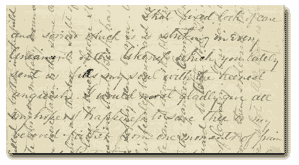Essay: Wartime Letterwriting
In this age of e-mail and instantaneous access to people half way around the globe, the concept of the handwritten letter may seem antiquated. Yet for soldiers during the Civil War, the letters written and received were a lifeline to loved ones at home.
Wartime created difficulties for postal delivery. Correspondents had to wait for days or weeks at a time to receive mail. In his book Letter Writing as a Social Practice, William Decker mentions this dilemma: "Letter exchanges proceed incrementally, against the constant possibility of being discontinued without notice" (Decker 50). Mail sent throughout the North was delivered as efficiently as it was before the war. Postal service amongst the South was less reliant (Scheele 86). Confederate letters and stamps were considered rebel insurgency by the Union and letters traveling between North and South went through a Union-controlled blockade, often confiscated by Union forces (Crown 165). In addition, soldiers were constantly on the move, which made for further delivery problems. If a letter was addressed and delivered to a soldier's last known address, there was no guarantee that its intended recipient was still stationed at that camp. Correspondents at home had to rely on information from a soldier's last letter regarding his whereabouts.
There are many examples of postal delivery difficulties found within the letters of the Civil War collection. One soldier talks about how his regiment captured the mail and went through it in order to learn enemy secrets. Another letter mentions that the mail has been robbed two or three times in the past week. A soldier implores his wife to write more often, not knowing if her letters have been captured or if she has simply not written. Compare this unsure situation with the instant gratification of e-mail. Today's soldiers have access to the internet, albeit for limited amounts of time. However, hurriedly reading and replying to e-mails while a line forms behind you does not compare with being able to sit down and write at length, as some letters in the collection illustrate.
Paper was a valuable commodity to soldiers. Many letters in the Civil War collection have additional writing in the margins (see fig. 1) or have a torn section after the signature. This was probably done to save the unused portion for another purpose. There are letters that have been written on twice, once in a normal left-to-right horizontal pattern and again with the paper having been turned 90°. (see fig. 2)
Often, letters are meant to be for one person or a particular set of individuals, i.e. a family, a group of friends. The reception of a letter was an event shared by all. One correspondent addresses his letters to "Dear friends" or to multiple family members. Not only was this to save paper, but to insure that those who were illiterate had the chance to "read" the letter.
With all of the hardships of battle, mail delivery continued to exist in the United States during the Civil War. Although channels of communication between the battlefield and home remained tenuous, the mail that did get through was readily welcomed on both sides. As one soldier wrote to his sister and brother-in-law in February 1863, "I sit myself upon my folded blankets with my portfolio upon my knee to pen a few lines in answer to a more than welcome letter just recd. from your hand & which I haste a reply."
References
- Barton, David and Nigel Hall, eds. Letter writing as a social practice. Philadelphia: John Benjamins Pub., 1999.
- Crown, Francis J. Jr., ed. Confederate postal history. Lawrence, MA: Quarterman Publications, Inc., 1976.
- Decker, William M. Epistolary practices: Letter writing in America before telecommunications. Chapel Hill: University of North Carolina Press, 1998.
- Scheele, Carl H. A short history of the mail service. Washington, D.C.: Smithsonian Institution Press, 1970.


